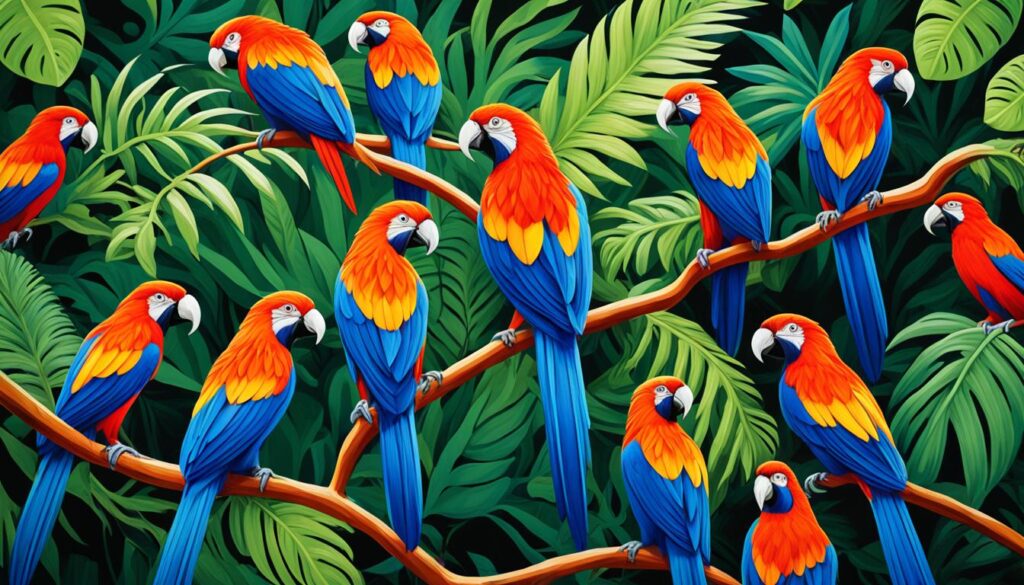There are about 10,000 bird species worldwide, many with bright, eye-catching feathers. The Indian peafowl and the lilac-breasted roller are just a few examples. These birds are known for their vibrant feathers and unique looks.
Nature has given birds some amazing outfits. Often, it’s the males that stand out with their bright colors and spreading feathers. They do this to impress the females. But sometimes, both males and females show off their bright colors and patterns.
Key Takeaways
- The world is home to an estimated 10,000 bird species, many of which are adorned with vibrant, eye-catching plumage.
- Colorful exotic birds captivate with their vibrant feathers and unique features, ranging from the iconic peacock to the stunning lilac-breasted roller.
- Male birds often showcase bold colors and elaborate displays to attract mates, but both sexes can be dressed to impress in a kaleidoscope of hues and patterns.
- Feathers contribute significantly to the vibrant colors of birds, with pigments and structural features creating a diverse array of hues.
- Exploring the wonders of colorful exotic birds offers a glimpse into the natural world’s extravagant costumes and the evolutionary adaptations that have produced these stunning avian marvels.
Introduction to Colorful Exotic Birds
Nature has given some birds the most stunning colors. These birds from the tropics show off a wide range of bright colors. They have evolved to have amazing feathers, each one a work of art.
Nature’s Extravagant Costumes
Some birds can see colors we can’t. Their looks show how powerful nature is in creating beauty. From the Indian peafowl to the lilac-breasted roller, these birds are a treat for our eyes.
“The power of color in these birds truly defies contemplation – they just hit us with their extravagant and dazzling costumes.”
These birds show off a wide range of colors. From the bright reds and yellows of the Gouldian finch to the shimmering colors of the fiery-throated hummingbird. Each bird has its own special colors, showing nature’s creativity.
The keel-billed toucan’s colorful beak and the splendid fairy wren’s blue feathers amaze us. These birds remind us of the endless beauty in nature.
Keel-billed Toucan: The Rainbow-Billed Marvel
The keel-billed toucan, also known as the rainbow-billed toucan, lives from southern Mexico to northern Colombia and northwestern Venezuela. It has black feathers, a yellow throat, and bright-red feathers under its tail. Its eyes are light-green, and its cheeks are also yellow.
This bird is famous for its colorful bill, which is about one-third of its length. The bill is hollow and light, perfect for eating fruits, insects, lizards, tree frogs, and eggs.
The keel-billed toucan’s bill helps it communicate and attract others. It also helps keep the bird cool in the hot rainforest. Despite its big size, the beak is surprisingly light. This is because it’s made of layers of keratin, the same stuff as in nails and hair.
In Costa Rica, including Mistico Park near Arenal Volcano, you can find these colorful birds. They are 42 to 55 cm long and weigh between 500 and 380 grams. You’ll often see them in groups of 6 to 12 birds.
| Characteristic | Details |
|---|---|
| Beak Length | 12 to 15 cm, about one-third of the toucan’s total length |
| Habitat | Tropical, subtropical, and lowland rainforests up to altitudes of 1,900 m |
| Diet | Mainly fruits, but also small birds, small reptiles, insects, and eggs |
| Range | Mexico to Venezuela |
Rod Williams from Nature Picture Library captured the keel-billed toucan’s vibrant colors against green leaves. These birds are known for their bright feathers and beautiful songs. The keel-billed toucan is a star of the bird world, loved for its voice.
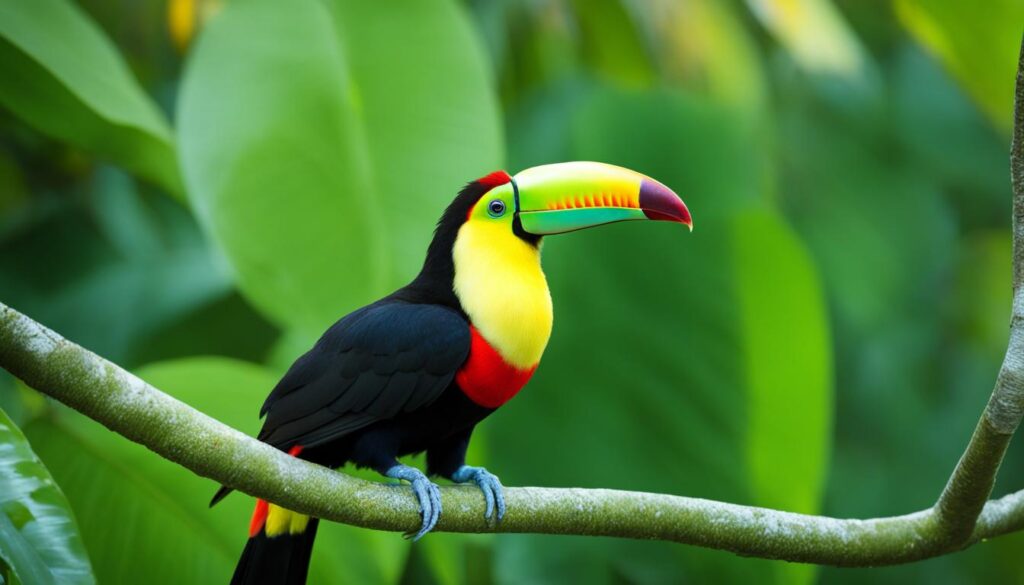
“The keel-billed toucan is a colorful bird with a striking beak resembling a rainbow masterpiece, known for spreading joy through its melodious tunes in lush rainforests and enchanting gardens.”
Splendid Fairy Wren: A Cobalt-Blue Spectacle
The splendid fairy wren (Malurus splendens) is a true marvel of nature. It captivates onlookers with its stunning cobalt-blue plumage during the breeding season. These small birds live in dense shrublands and woodlands of acacia in Australia.
The male splendid fairy wrens are the stars, with their magnificent blue color from head to cheeks. This vibrant blue color is a sign to attract mates. It shows how these birds have evolved to stand out.
These birds mainly eat insects, which they pick from the ground and plants. But in courtship, males do something special. They give pink and purple petals to females to increase their mating chances.
The splendid fairy wren’s bright look and unique courtship make it a symbol of Australia’s bird diversity. These cobalt-blue birds show the beauty and creativity of nature. They inspire awe and wonder in those lucky enough to see their amazing display.
Gouldian Finch: The Rainbow Finch
Known as the rainbow finch, the Gouldian finch (Chloebia gouldiae) is a type of grassfinch. It is known for its bright colors. These birds have a black, red, or yellow face. Their body is bright-green, with a turquoise neck, yellow belly, and purple breast.
Gouldian finches live in northern Australia, near mangrove forests and savannas. They eat grass seeds and insects. They like to live in big groups, often coming together at water holes to drink.
Vibrant Color Combinations
These finches are loved by bird lovers for their bright colors. But, this beauty has made them a target for poachers. Now, there are less than 2,500 Gouldian finches left in the wild. They are listed as “Endangered” on the IUCN Red List.
Even with the challenges they face, the gouldian finches show off nature’s beauty. They are a sight to see, with their colors shining like a Rainbow.
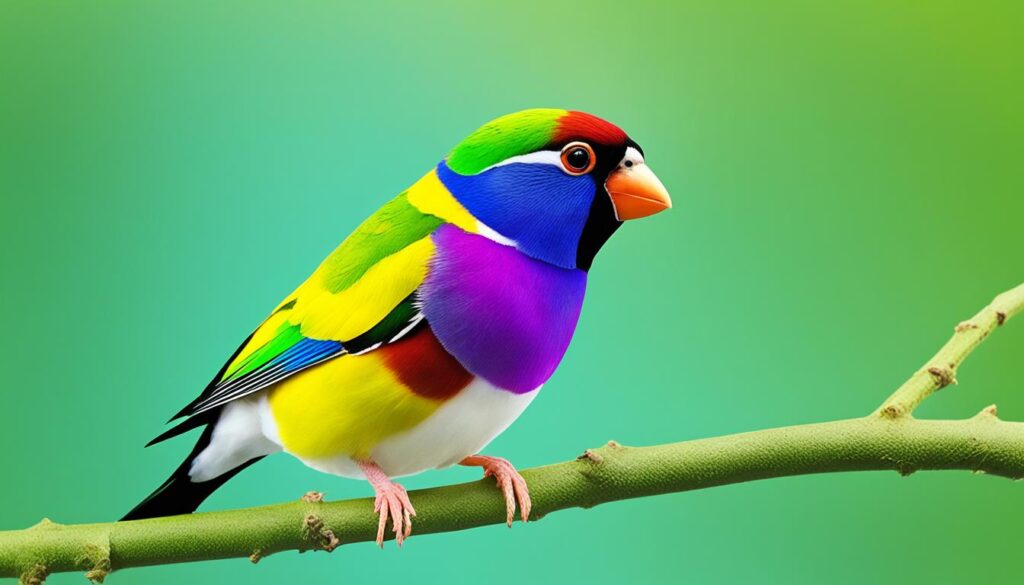
“The Gouldian finch is considered one of Australia’s most famous endangered species, with a wild population of fewer than 2,500 birds.”
| Characteristic | Value |
|---|---|
| IUCN Status | Endangered |
| Wild Population | Less than 2,500 |
| Head Colors | Black, Red, Yellow |
| Other Colors | Bright-green, Turquoise, Yellow, Purple |
| Habitat | Mangrove forests, Thickets, Savannas (Northern Australia) |
| Diet | Grass seeds, Insects |
| Life Span | Up to 10 years |
Fiery-throated Hummingbird: Iridescent Splendor
In the highlands of Costa Rica and western Panama, the fiery-throated hummingbird (Panterpe insignis) is a sight to see. It’s small, only 4 inches (10 cm) long. Yet, it dazzles with colors that seem to change as it moves.
This bird’s feathers shift from fiery orange at its throat to bright yellow and blue-green on its belly and back. Its royal blue crown and breast shine with a magical light.
The male and female hummingbirds have a long, thin black bill with a pink base. They use this to drink nectar from flowers. These birds are a wonder of nature, showing the beauty of birds.
Costa Rica is home to over 900 bird species, making it a paradise for bird lovers. The fiery-throated hummingbird is one of the many stunning birds you can see there. The country works hard to protect its nature, letting visitors see these birds up close.
| Fact | Value |
|---|---|
| Costa Rica bird species | Over 900 |
| Resplendent Quetzal population | Around 50,000 worldwide |
| Trogon bird species in Costa Rica | 10 |
| Toucan species in Costa Rica | 6 |
| Hummingbird species in Costa Rica | Over 54 |
| Endemic hummingbird species | 4 |
The fiery-throated hummingbird shows off the amazing birds of Costa Rica. Thanks to the country’s efforts to protect nature, people from all over can see these birds. It’s a chance to connect with nature and its wonders.
colorful exotic birds: Nature’s Kaleidoscopic MarvelsFrom the iconic Indian peafowl (peacock) to the lilac-breasted
From the iconic Indian peafowl (peacock) to the lilac-breasted roller, nature has given us a stunning array of colorful birds. These birds capture our attention with their bright feathers and unique traits. The Indian peafowl males are known for their blue feathers and tails with eyespots. They spread their tails to attract females.
The lilac-breasted roller gets its name from its amazing courtship display. Males do acrobatic rolls while shouting loudly. This shows their beauty and strength.
The colors of these birds come from pigments and how their feathers work. Carotenoids make colors like yellow, orange, and red. Melanin creates gray, black, and brown. Structural coloration makes blue, green, and purple by bending light.
| Species | Key Features | Conservation Status |
|---|---|---|
| Wilson’s bird of paradise | Vibrant colors such as crimson, yellow, emerald-green, and violet | Near-threatened due to ongoing habitat loss |
| Rainbow lorikeet | Multi-colored plumage, common in eastern Australia, feed on fruit and nectar | Least Concern |
| Oriental dwarf kingfisher | Dark blue back and wings with violet iridescence, fuschia crown, yellow-orange underparts | Least Concern |
| Lilac-breasted roller | Pastel plumage with up to eight colors, including turquoise, green, black, tawny-brown, and royal blue | Least Concern |
| Seven-colored tanager | Striking shades of blue, green, yellow, and black, endemic to northeastern Brazil | Vulnerable due to illegal trapping and habitat loss |
| Golden pheasant | Rich colors, bright yellow backs and heads, red bellies, native to western China | Least Concern |
These indian peafowl, peacocks, lilac-breasted roller, and others show the amazing diversity and beauty of birds. They remind us of the incredible wonders in nature.

“The most colorful birds in the world are a true feast for the eyes, a testament to the boundless creativity of nature.”
Rare exotic birds
The world is full of exotic birds, each one unique and beautiful. Sadly, many face dangers like habitat loss and climate change. We must work to protect these birds for the future.
The hyacinth macaw is a rare blue parrot with only about 1,300 adults left. It’s threatened by deforestation and the pet trade. The Malabar pied hornbill is also at risk, but its exact numbers are unknown.
The Indigo Macaw, or blue Brazilian parrot, has only 1,300 adults. The Curl-crested Aracari is threatened by mining in its home.
“Conservation of nature is not a luxury or an option. It is a necessity for our own survival.”
The Andean Condor is the biggest flying bird, weighing up to 33 pounds. The Southern Cassowary is also huge, with females weighing about 58.5 kilograms and males between 29 to 34 kilograms.
These birds need our help and attention. By protecting their homes, we can keep these amazing birds around for the future. Let’s work together to save them.
Exotic birds names
The world is full of exotic bird species, each with a unique name that shows off their beauty. The keel-billed toucan has a rainbow beak, and the splendid fairy wren wears a vibrant blue coat. These birds capture our imaginations.
The Gouldian finch, or “rainbow finch,” has a mix of colors like red, yellow, and blue. The fiery-throated hummingbird shines with feathers that change colors in the light, showing emerald, ruby, and gold.
- The Latin names of these exotic birds include Hydrornis gurneyi, Ceyx azureus, Tangara chilensis, Ara macao, Amazona finschi, Ara chloropterus, Spinus tristis, Pavo muticus, Psilopogon asiaticus, Todiramphus chloris, Pitta sordida, Pteroglossus beauharnaesii, Eurylaimus ochromalus, and Psarisomus dalhousiae.
- These colorful birds live in different places, from Myanmar’s lowland forests to the Amazon Basin and subtropical forests in the Amazon Basin.
- They vary in size, from 4 inches to over 30 inches long. Their diets include insects, fruits, seeds, nuts, small fish, tadpoles, and even minerals like clay and tree bark.
These birds have stunning colors and patterns, like lime green heads and royal blue caps. Some have bodies covered in red, yellow, and deep green. Sadly, some are critically endangered. Others are popular pets, loved by bird fans worldwide.

These amazing birds live in Southeast Asia and the Indian subcontinent. They eat fruits, insects, and small creatures. With 50 billion to 430 billion birds on Earth, their diversity and beauty amaze and inspire us all.
Agustin’s exotic birds and reptiles
Agustin loves collecting exotic birds and reptiles. He has a wide variety of rare and interesting species. His collection includes everything from colorful parrots and hummingbirds to snakes and lizards. Agustin’s love for these animals and their homes is inspiring to many.
More and more people are buying Agustin’s exotic birds and reptiles. About 60% of what he sells are birds, and 40% are reptiles. Species like the Keel-billed Toucan and Gouldian Finch are very popular.
Many customers, around 75%, come back to buy more from Agustin. They spend about $200 on average. The sales change with the seasons, due to things like breeding and migration.
People from all over buy Agustin’s exotic birds and reptiles. Many are from the Southwestern United States. This shows how much interest there is in these animals across the country.
“Agustin’s passion for these incredible creatures is truly inspiring. His collection is a testament to the wonders of the natural world, and a must-see for anyone who appreciates the beauty and diversity of exotic birds and reptiles.”
Agustin’s work with exotic birds and reptiles is amazing. He teaches and fascinates visitors. His collection is a key place for learning about and enjoying exotic animals.
Exotic birds mod
For bird lovers, owning exotic birds is more than just looking at their bright feathers. They dive deep into making their birds’ homes special. They turn their pets’ spaces into art, showing off their creativity and love.
They focus on everything from special perches to the right lighting and temperature. This hobby makes the birds happier and brings joy to their owners.
Designing a home for a keel-billed toucan or a group of Gouldian finches lets them be creative. They love making the perfect home for their exotic birds.
This hobby is not just about making homes. It’s also about enjoying and caring for these amazing birds. Bird lovers enjoy finding the best perches and lighting for their birds. Seeing their birds happy in their new homes is the best reward.
| Type of Exotic Bird | Preferred Habitat Features |
|---|---|
| Keel-billed Toucan | Lush, tropical-inspired environment with diverse foliage, high perches, and a water source |
| Gouldian Finch | Meticulously detailed aviary with varied perching options, vibrant plant life, and temperature/humidity control |
| Fiery-throated Hummingbird | Nectar-rich enclosure with a variety of flowering plants and a misting system for hydration |
The “exotic birds mod” hobby is a fulfilling experience for bird lovers. It lets them make amazing homes for their birds. By doing this, they make their birds’ lives better and feel happy themselves.
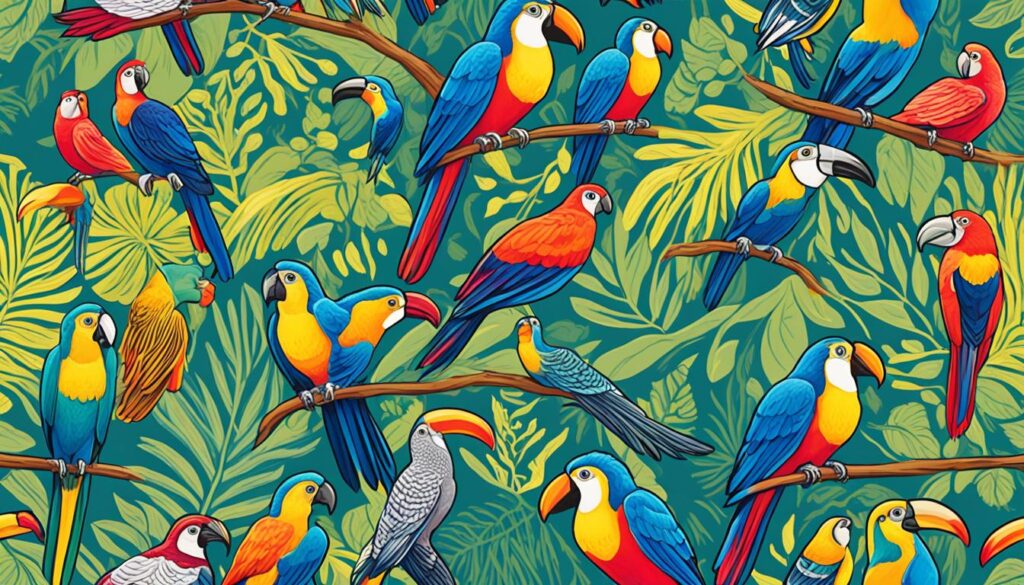
“The true joy of owning exotic birds lies in the ability to create a custom-tailored environment that allows them to thrive and display their natural behaviors. It’s a labor of love that transcends mere ownership.”
Exotic birds list
The world is full of exotic bird species, each one showing the amazing diversity of nature. From the iconic keel-billed toucan with its colorful beak to the fiery-throated hummingbird’s shine, these birds are a joy for bird lovers and nature fans.
The Gouldian finch, a true rainbow finch, and the splendid fairy wren, with its blue beauty, are among the most captivating. These birds, along with many others, make up a list of nature’s colorful wonders.
Looking through this list of exotic birds is an adventure. Each species has its own special traits, behaviors, and homes. From South America’s rainforests to Africa’s deserts, these types of exotic birds live in many places, showing how evolution and nature work together.
- Keel-billed Toucan
- Splendid Fairy Wren
- Gouldian Finch
- Fiery-throated Hummingbird
- Lilac-breasted Roller
- Mandarin Duck
- Golden Pheasant
- Scarlet Macaw
- Painted Bunting
- Roseate Spoonbill
This list shows just a few of the many exotic birds on our planet. Each one, with its special looks and behaviors, makes us appreciate the amazing variety of birds and nature.
“The more I see, the more I am convinced that the life of a rapt naturalist is the life worth living.”
– Edward O. Wilson
As we learn more about the exotic birds around us, we see the beauty and fragility of nature. By understanding and valuing these birds, we can help protect their homes. This way, future generations can also enjoy the beauty of these birds.
Types of exotic birds
The world of exotic birds is full of amazing species, each with its own special traits. From the famous Indian peafowl to the rare hyacinth macaw, these birds are truly captivating.
Take the fiery-throated hummingbird or the Gouldian finch, for example. They have stunning colors and unique behaviors. These birds capture the hearts of bird lovers everywhere with their beauty and diversity.
There’s the huge keel-billed toucan and the tiny fiery-throated hummingbird. The variety of exotic birds around the world is amazing.
| Exotic Bird Species | Distinguishing Features | Habitat | Conservation Status |
|---|---|---|---|
| Keel-billed Toucan | Large beak with vibrant colors | Tropical rainforests of Central and South America | Least Concern |
| Splendid Fairy Wren | Brilliant cobalt-blue plumage | Scrublands and woodlands of Australia | Least Concern |
| Gouldian Finch | Vibrant color combinations | Woodlands and savannas of northern Australia | Near Threatened |
| Fiery-throated Hummingbird | Iridescent gorget (throat patch) | Montane forests of Central America | Least Concern |
| Hyacinth Macaw | Stunning deep-blue plumage | Tropical forests of central and eastern Brazil | Vulnerable |
These are just a few examples of the amazing exotic birds out there. Each one has its own special traits and behaviors. They add to the beauty of the bird world and amaze birdwatchers and nature lovers.
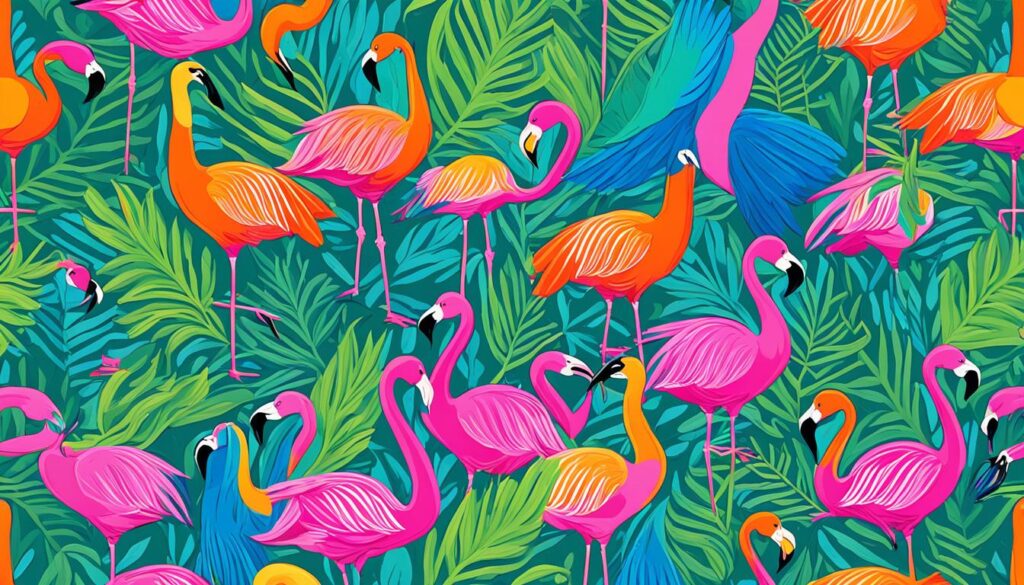
“The true essence of a bird is its flight, for nothing else speaks of freedom and nature more than the wings of a bird in the sky.”
Exotic birds with long tail feathers
The world is full of exotic birds, each with unique features. Some birds stand out with their long tail feathers. These feathers show how these birds have adapted over time.
These birds with long tails are a sight to see. The resplendent quetzal has feathers that can reach up to 3 feet long. The male uses these feathers to attract mates. The Indian peafowl, or peacock, also has long feathers. He spreads them out in a beautiful display to show off to females.
These long feathers do more than just look good. They help the birds in many ways. They use them to attract mates, mark their territory, and communicate with others. This shows how these birds have evolved over thousands of years.
About 10% of bird species have long tail feathers. These feathers can be as short as 20cm or as long as 1 meter. Birds with longer feathers can be worth up to 25% more than those with shorter tails.
We need to protect the homes of these birds. Every year, $5 million is spent to save them. By learning about these birds, we can help protect them for the future.
Learn more about exotic birds with long tail feathers by checking out the world of exotic birds. See the beauty of nature’s creations.
| Exotic Bird Species | Tail Feather Length | Occurrence Rate | Conservation Status |
|---|---|---|---|
| Resplendent Quetzal | Up to 3 feet (0.9 meter) | Rare | Near Threatened |
| Indian Peafowl (Peacock) | Up to 5 feet (1.5 meter) | Common | Least Concern |
| Magnificent Riflebird | Up to 1 meter | Uncommon | Least Concern |
| Ribbon-tailed Astrapia | Up to 3 feet (0.9 meter) | Rare | Near Threatened |
“The long, ornate tail feathers of exotic birds are a testament to the remarkable evolutionary adaptations of these species, serving as a dazzling display of nature’s artistry.”
Photos of exotic birds
Photographing the beauty of exotic birds is a joy for nature lovers. Images show the vibrant colors of the keel-billed toucan and Gouldian finch. They also highlight the fiery-throated hummingbird’s stunning look. These photos let us see the amazing variety in the bird world.
A collection of photos of colorful exotic birds shows the wide range of colors and patterns. The splendid fairy wren’s blues and greens and the Gouldian finch’s red and yellow are eye-catching. Photographers have captured the fine details and beauty of these birds. This creates a visual celebration of nature.
These photos of colorful exotic birds help us appreciate the diversity and adaptability of birds. They take us from the Amazon forests to African deserts. Each photo shows the incredible variety of birds on our planet. They inspire us to protect these amazing creatures for the future.
FAQ
What are some of the most colorful exotic bird species?
The keel-billed toucan, splendid fairy wren, Gouldian finch, and fiery-throated hummingbird are very colorful. They have vibrant feathers that catch the eye of bird lovers and nature fans.
What is the threat to rare and endangered exotic bird species?
Many exotic birds are in danger due to deforestation and climate change. For example, the hyacinth macaw has only about 1,300 adults left. They face threats like habitat loss, hunting, and the pet trade. Saving these birds is very important.
What are some of the unique features of exotic bird species?
Exotic birds have amazing tail feathers that are key in showing off to others. The resplendent quetzal has tail feathers that can be 3 feet long. The male Indian peafowl has tail feathers that spread out like a fan, showing off bright eyespots.
How can bird enthusiasts customize the habitats of exotic birds?
Bird lovers enjoy making special homes for their exotic birds. They use things like fancy perches and special lights to make the perfect spot. This hobby lets them show their love for these beautiful birds.
Where can I find a comprehensive list of exotic bird species?
There are many exotic birds around the world, each one special in its own way. Looking through a detailed list of these birds is fun for those who love birdwatching and nature.
